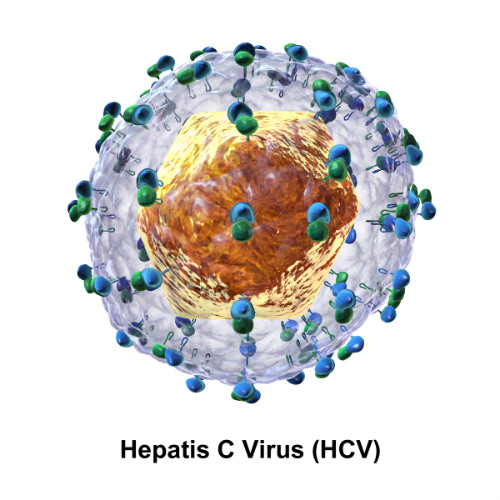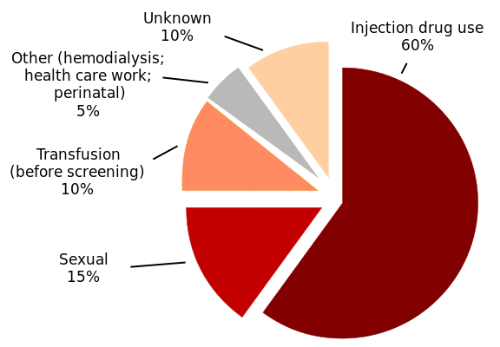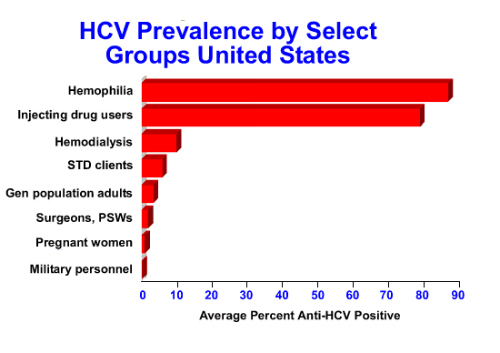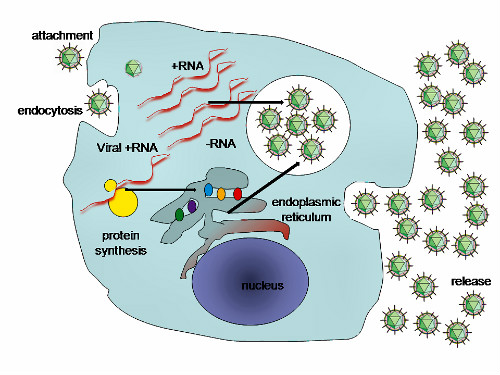- According to the CDC, deaths related to hepatitis C virus (HCV) infection reached an all-time high in 2014.
- HCV was the most lethal infectious disease in 2014.
- Mortality continues to increase despite an available cure and improvements in treatment.
- Greatest mortality rate is among people born between 1945 and 1965, many of whom do not know they are infected.
Hepatitis C (Figure 1) killed more Americans than any other infectious disease in 2014, according to the Centers for Disease Control and Prevention (CDC). Deaths related to hepatitis C virus (HCV) infection reached an all-time high of 19,659 in 2014, according to the new CDC data. Despite recent advances in treatment–and an available cure–hepatitis C deaths continue to rise.

(Source: BruceBlaus/Creative Commons/Wikipedia. )
The highest rate of HCV-related mortality and morbidity was found among baby boomers, many of whom have unknowingly lived with the infection for years. According to a study published recently in Lancet Infectious Diseases many baby boomers were infected during medical procedures in the years after World War II, when now standard hygienic practices were not standard. Because so many of these people did not know they were infected, they may have unknowingly transmitted the disease to others. (Figure 2.)

(Source: Optigan13/CDC/Wikipedia.)
Mortality among people infected with HCV is also increasing. For the first time in the U.S., the number of HCV-related deaths (n=15,106) exceeded the number of HIV/AIDS-related deaths (n=12,734) in 2007 and has continued to increase. The number of HCV-related deaths rose to 19,659 in 2014 and more than half of these deaths occurred among people 55-64 years. In 2013, the CDC and the U.S. Protective Services Task Force (USPTF) began to recommend one-time testing for HCV infection among adults born during the period from 1945 to 1965.
Bad Omen
The new surveillance data suggest that a new wave of hepatitis C infections can be expected among people who inject drugs. “Acute cases of hepatitis C infection have more than doubled since 2010, increasing to 2,194 reported cases in 2014,” the CDC noted. “The new cases were predominantly among young, white individuals with a history of injection drug use, living in rural and suburban areas of the Midwest and Eastern United States.” (Figure 3.)

Source: CDC/Wikipedia/Creative Commons.)
“Because hepatitis C often has few noticeable symptoms, the number of new cases is likely much higher than what is reported. Due to limited screening and under reporting, we estimate the number of new infections is closer to 30,000 per year,” said John W. Ward, MD, Director of CDC’s Division of Viral Hepatitis. “We must act now to diagnose and treat hidden infections before they become deadly and to prevent new infections.”
A significant portion of the U.S. public health future rests upon our ability to address the viral hepatitis risk among people who inject drugs. The CDC has recommended that prevention programs be implemented to avert drug-related transmission of HCV infection. “These prevention programs should include regular testing for hepatitis C (as well as hepatitis B and HIV); rapid links to medical care for people who test positive; and access to substance abuse treatment, sterile injection equipment, and other services,” the CDC advised.
Current Burden
Approximately 3.5 million Americans are currently living with HCV infection. Roughly 50% are unaware of their infection. The CDC and the U.S. Preventive Services Task Force “recommend one-time hepatitis C testing for everyone born from 1945 to 1965 and regular testing for others at high risk. Once diagnosed, patients can take advantage of new, highly effective treatments that can cure the vast majority of infections in two to three months and take other steps to protect their health.”
The CDC “is committed to helping communities use all effective tools to stop the spread of hepatitis C and reduce deaths associated with the disease. Through collaborative efforts, we can help reduce the rise in new infections and reverse trends in hepatitis C-related mortality, ultimately ensuring that far fewer people die of this disease.”
Recent and Current Data
The CDC received reports of cases of acute HCV infection (Figure 4) that ranged from 781 to877 during the period between 2006 and 2010. Then, between 2010 and 2014 the reported cases of acute HCV infection increased more than 2.5 times. In the following years, cases of HCV infection rose from 850 in 2010 to 1,232 in 2011, 1,778 in 2012, 2,138 in 2013, and 2,194 in 2014.

(Source:GrahamColm at English Wikipedia - Transferred from en.wikipedia to Commons by Leptictidium using CommonsHelper.)
The increase observed in the period between 2010 and 2014 is thought to reflect both true increases in incidence as well as to improved diagnosis. “Based on new epidemiologic studies, at least 4.6 million persons are HCV-antibody positive and approximately 3.5 million are currently infected with HCV. New cases of HCV infection are predominately among young persons who are white, live in non-urban areas (particularly in Eastern and Midwestern states), have a history of injection-drug use, and previously used opioid agonists such as oxycodone,” the CDC noted.
The CDC funded an enhanced surveillance program in Florida, Massachusetts, and New York. The effects of this program may partially explain the increased number of detected HCV infection in these states. “In other locations where the number of cases has increased markedly (e.g., Kentucky, Tennessee, Virginia, and West Virginia), increases have occurred without any federal support for investigation or follow-up, reflecting overall increases in incidence. After adjusting for under-ascertainment and under-reporting, an estimated 30,500 new HCV infections occurred in 2014,” the CDC press release explains.
